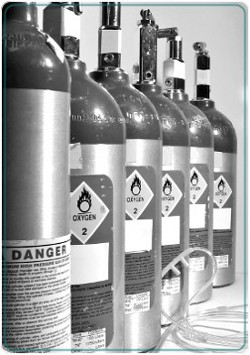
Some oxygen patients may wonder what a conserving device is used for and why it's so important. Today we'd like to tell you just that!
Pneumatic oxygen conservers include a combination of a low pressure regulator and an oxygen conserver. These are designed for use with a cylinder as an ambulatory oxygen system.
When we breathe, approximately one-third of the time is spent inhaling. The remaining two-thirds of that time is spent exhaling. As a result, oxygen delivered by continuous flow is wasted during exhalation. By eliminating oxygen flow during exhalation, a two-thirds savings is possible.
This then gives us the advantage of prolonging the time an oxygen cylinder will last. Oxygen patients who use portability will be able to enjoy extended time away from home using the same oxygen cylinder.
Visit the
portability section of our website for basic guidelines on how long cylinders will last while using a conserving device.


Staying healthy is more important now than ever before for patients with chronic obstructive pulmonary disease (COPD) and other respiratory illnesses. We all have heard we should wash our hands often, care for our teeth and gums, and avoid germs and germ-filled areas.
But there are more ways to stay healthy you may not have considered. Try these tips to improve your health this winter:
- Drink plenty of fluids, especially water and juice. Consult with your physician to determine your optimum intake. Drinking before your evening meal should minimize interruptions during the night.
- Add humidity to the air with a humidifying device. Be sure to keep it clean and germ-free. Clean regularly to ensure optimum performance.
- Cold air hurts. When outside, breathe through your nose (this will help add humidity to the air). Wrap a scarf around your face before you go outside. Also, when you first step outside, stop and take a few short breaths before proceeding. This will help your body become adjusted and may save you from a coughing spell.
- Avoid colds and people with them as their germs are airborne. If they must be near you, ask them to wear a surgical face mask. Avoid using their plate or utensils.
- Keep your nose clean. Blow your nose as often as is necessary using fresh, disposable tissues so you may rid of them after.
- Stay active. Exercise is important year-round. If the weather is too poor to exercise outside, try walking around the house and climbing stairs. Consider investing in a piece of home exercise equipment to keep your regimen going during the winter months. [Be sure to consult with your physician prior to starting any new exercise program.]
- Avoid dust. If you have central heating, replace your air filters before turning your system on for the season. Dust frequently with a dusting agent that traps the dust on the cloth. Wash or dry-clean drapes and curtains. Vacuum or dust behind radiators and be sure to change your vacuum cleaner bags and filters regularly.
- Maintain a healthy weight. During winter months, aim to stay at or a little below your ideal weight. Eating and digesting food can be exhausting, so consider eating 5-6 small meals a day instead of 3 larger ones.
- Consider a flu shot in the fall, before flu season begins. Ask your physician about getting the flu vaccine. Be sure to rest in the days leading up to obtaining the vaccine.
- Avoid smokers. Smoke from someone else's cigarette can be as irritating and harmful to you as if you were smoking. Ask your friends not to smoke, or to smoke away from out (outside or in another room).
 Source: Autumn and Winter Advice for Respiratory Patients. COPD Support. Retrieved February 15, 2013 from http://www.copdsupport.ie/copd-support-group/autumn-and-winter-advice.
Source: Autumn and Winter Advice for Respiratory Patients. COPD Support. Retrieved February 15, 2013 from http://www.copdsupport.ie/copd-support-group/autumn-and-winter-advice.

Your dependency on supplemental oxygen doesn't need to prevent you from traveling and enjoying your life! In 2009, the U.S. Department of Transportation issued a final rule requiring all commercial airlines to accept patients traveling with portable oxygen concentrators (POCs). Traveling successfully with a POC begins during the planning stages of your trip. Please refer to the following helpful tips for oxygen users traveling by airplane:
- Before you make travel plans, check with your doctor to determine what extra precautions must be taken.
- Contact your home care provider several weeks before you plan to travel to make arrangements concerning oxygen supplies and equipment for you while traveling and at your destination.
- Be prepared to make several contacts with your travel agent and/or the airline. Each airline has specific rules and regulations. Some airlines may require specific forms of notification of oxygen service to be submitted to them prior to travel. In most cases, your physician will need to fill out and sign the forms.
- Request an aisle seat for ease of movement and for allowing more room to change your POC battery.
- Notify the airline of any other special needs prior to traveling. These needs may include wheelchairs, motorized cart, etc.
- Reconfirm your travel plans with the airline at least 72 hours in advance.
- Arrive at the airport well in advance to allow ample time for check-in and security. Going through security takes time as both the POC and extra battery will have to be checked and scanned.
- Take advantage of the option to pre-board.
- Stay charged up! When using a POC, estimate the battery discharge rate for the flight time and multiply that by at least 2 to accommodate flight delays and increased power utilization.
For more helpful airline travel tips, please
click here to read Up, Up, and Away published in the May 2009 American Association of Respiratory Care Times.

Are you on the lookout for clean air?
If you're like most Americans, the air you breathe probably isn't something you give much thought to.
The American Lung Association released
some interesting statistics based on their
2012 State of the Air report:
- Almost half of all Americans (41%) live in counties that have unhealthy levels of ozone or particle pollution
- Over 6 million people live in areas with unhealthy levels of year-round particle pollution
- One in six people live in areas with unhealthy levels of short-term particle pollution
What does this mean to you? Well, if you live in one of the affected areas, you may have experienced times when it was difficult to breathe. And if you suffer from asthma or COPD, breathing can be difficult enough without added pollutants.
Is there anything that can be done to help improve these statistics?
The American Lung Association recommends:
- Driving less: take advantage of public transportation, bike, or walk places since vehicle emissions account for a large part of air pollution
- Use less electricity: use energy efficient appliances and turn lights off when leaving the room since generating electricity is one of the biggest sources of air pollution
- Don't burn wood/trash: dispose of waste properly since burning releases many particles into the air; if you want to have a fire, use natural gas which has far fewer pollutants
- Send a message to local representatives: let your Congressmen, Assemblymen, Senators, Governors, and Mayors know that you support the Clean Air Act and want healthier, cleaner air to breathe
You can
download the 2012 State of the Air report here to read their full findings.


People suffering from COPD (chronic obstructive pulmonary disease) may not normally look to acupuncture to help ease their symptoms. But a study published this past June by
the Archives of Internal Medicine may cause COPD patients to think otherwise.
This study, conducted over the course of almost three years, divided patients into two groups: those who received actual acupuncture, and those who received placebo (fake) acupuncture. Both groups received their treatments once a week over the course of twelve weeks and in the same body locations.
After the twelve-week treatment sessions were complete, patients underwent a 6-minute walk test. They were then rated according to a modified 10-point Borg scale which measures breathlessness from 0 to 10 where 0 equals "breathing very well" and 10 equals "severely breathless."
Patients who had received real acupuncture scored markedly better on the Borg scale versus the placebo group. They also showed better exercise tolerance overall, showing that acupuncture can be a useful therapy for those suffering from COPD.
Those that are interested can
read the full study here.

 Some oxygen patients may wonder what a conserving device is used for and why it's so important. Today we'd like to tell you just that!
Some oxygen patients may wonder what a conserving device is used for and why it's so important. Today we'd like to tell you just that!
 Staying healthy is more important now than ever before for patients with chronic obstructive pulmonary disease (COPD) and other respiratory illnesses. We all have heard we should wash our hands often, care for our teeth and gums, and avoid germs and germ-filled areas.
Staying healthy is more important now than ever before for patients with chronic obstructive pulmonary disease (COPD) and other respiratory illnesses. We all have heard we should wash our hands often, care for our teeth and gums, and avoid germs and germ-filled areas. Your dependency on supplemental oxygen doesn't need to prevent you from traveling and enjoying your life! In 2009, the U.S. Department of Transportation issued a final rule requiring all commercial airlines to accept patients traveling with portable oxygen concentrators (POCs). Traveling successfully with a POC begins during the planning stages of your trip. Please refer to the following helpful tips for oxygen users traveling by airplane:
Your dependency on supplemental oxygen doesn't need to prevent you from traveling and enjoying your life! In 2009, the U.S. Department of Transportation issued a final rule requiring all commercial airlines to accept patients traveling with portable oxygen concentrators (POCs). Traveling successfully with a POC begins during the planning stages of your trip. Please refer to the following helpful tips for oxygen users traveling by airplane: People suffering from COPD (chronic obstructive pulmonary disease) may not normally look to acupuncture to help ease their symptoms. But a study published this past June by
People suffering from COPD (chronic obstructive pulmonary disease) may not normally look to acupuncture to help ease their symptoms. But a study published this past June by